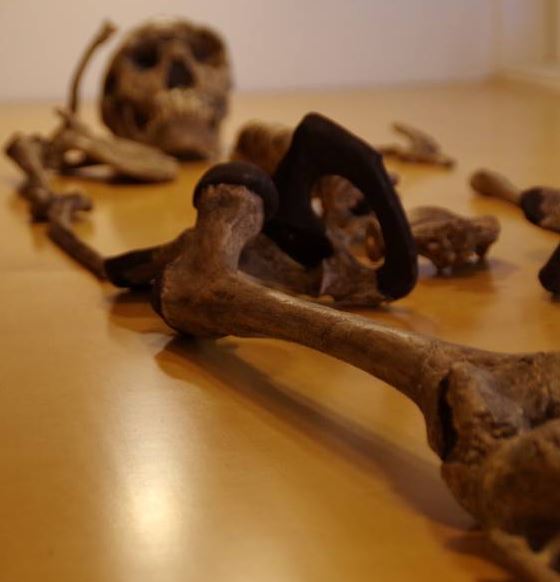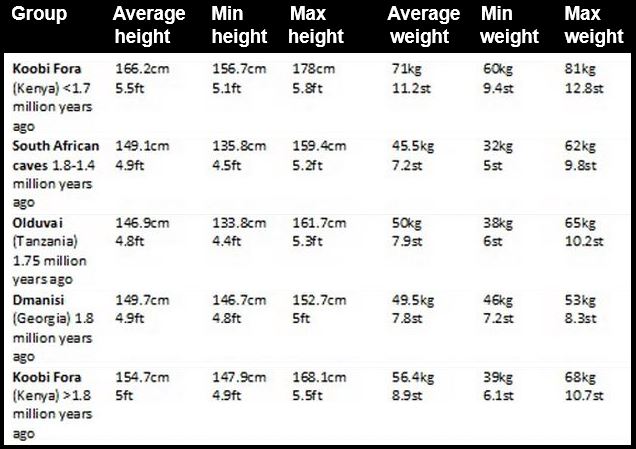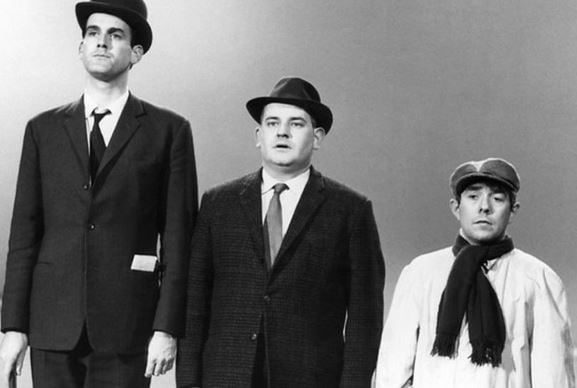A new study challenges the theory that early humans were small and became taller, heavier and longer-legged in time. Early humans, i.e. between 2.5 million and 1.5 million years ago, ranged in height from 4 ft 8 inches to 6 feet, just like modern humans do.
Scientists have long known that Homo erectus had an average height of less than 152 cm (five feet) and weighed under 50 kg (110 lbs), according to fossils found in Georgia in southern Europe dating back to 1.77 million years ago.
Not much was known, however, about the timing and geographic origins of larger early humans, the ones we associated with modern humans, until now.

The Turkana boy (Homo erectus), 1.5 million years old. The femur is commonly used for mathematical calculations of body size because it is the biggest bone and carries much of the body’s weight. (Photo: Jay Stock)
The findings from this latest research have been published in the Journal of Human Evolution (citation below).
A study carried out by researchers from the Universities of Cambridge in England and Tübingen in Germany shows that the main increase in body size happened tens of thousands of years after Homo erectus migrated from Africa, and primarily in the Koobi Fora region of Kenya.
Co-author, PhD student Manuel Will, who works at the Department of Early Prehistory and Quaternary Ecology at Tübingen, said:
“The evolution of larger bodies and longer legs can thus no longer be assumed to be the main driving factor behind the earliest excursions of our genus to Eurasia.”
Early humans came in many sizes
According to the scientists, their new research method – using small fragments of fossils to estimate height and body mass – showed that early humans came in many weights and heights, just like modern humans today.
Co-author Dr. Jay Stock, from the Department of Archaeology and Anthropology at the University of Cambridge, said:
“What we’re seeing is perhaps the beginning of a unique characteristic of our own species – the origins of diversity.”
“It’s possible to interpret our findings as showing that there were either multiple species of early human, such as Homo habilis, Homo ergaster and Homo rudolfensis, or one highly diverse species. This fits well with recent cranial evidence for tremendous diversity among early members of the genus Homo.”
“If someone asked you ‘are modern humans 6 foot tall and 70kg?’ you’d say ‘well some are, but many people aren’t,’ and what we’re starting to show is that this diversification happened really early in human evolution.”
This is the first study in two decades to compare the height and weight of humans who were around at the same time as the sabre-toothed cats and mammoths between 2.5 million and 1.5 million years ago.
It is also the first time that many minuscule fossils – some as small as tiny ankle bones and toes measuring no more than 5 cm – have been used to estimate body size.

Image source: University of Cambridge.
After comparing fossil measurements from sites in Georgia, South Africa, Tanzania and Kenya, the scientists found that there was considerable regional variation in the weight and height of early humans during the Pleistocene (from about 2,588,000 to 11,700 years ago).
Some groups, such as those living in South African caves, averaged just 4.8 feet in height, while a number of fossils found in Kenya’s Koobi Fora region showed that humans were nearly 6 foot tall, which is similar to the height of the average modern adult British male.
Dr. Stock said:
“Basically every textbook on human evolution gives the perspective that one lineage of humans evolved larger bodies before spreading beyond Africa. But the evidence for this story about our origins and the dispersal out of Africa just no longer really fits.”
“The first clues came from the site of Dmanisi in Georgia where fossils of really small-bodied people date to 1.77 million years ago. This has been known for several years, but we now know that consistently larger body size evolved in Eastern Africa after 1.7 million years ago, in the Koobi Fora region of Kenya.”
“We tend to simplify our interpretations because the fossil record is patchy and we have to explain it in some way. But revealing the diversity that exists is just as important as those broad, sweeping explanations.”

The study found that just like today, early humans came in many sizes.
Previous studies relied on few samples
Previous studies have relied on evidence from small samples of just ten to fifteen fossils, because techniques for calculating body mass and height of individuals required certain pieces of bone such as most of a leg bone or hip joint.
Dr. Stock and Mr. Will have used samples size three times bigger, estimating body sizes from more than 40 specimens gathered from all over Africa and Georgia. Theirs is the largest comparative study concluded so far.
Rather than waiting for new fossils containing these specific bones to turn up, the researchers decided to try a different approach and examine previously overlooked fossils.
In what Dr. Stock described as a “very challenging project,” he and Mr. Will spent a year developing new equations that allowed them to estimate the body mass and height of individuals using far smaller bones.
They compared these bones to measurements taken from more than 800 skeletons of modern hunter gatherers from across the world and applied various regression equations. They were able to estimate body size for several new fossils that had never been studied in this way before.
Dr. Stock said:
“In human evolution we see body size as one of the most important characteristics, and from examining these ‘scrappier’ fossils we can get a much better sense of when and where human body size diversity arose. Before 1.7 million years ago our ancestors were seldom over 5 foot tall or particularly heavy in body mass.”
“When this significant size shift to much heavier, taller individuals happened, it occurred primarily in one particular place – in a region called Koobi Fora in northern Kenya around 1.7 million years ago. That means we can now start thinking about what regional conditions drove the emergence of this diversity, rather than seeing body size as a fixed and fundamental characteristic of a species.”
Citation: “Spatial and temporal variation of body size among early Homo,” Manuel Will and Jay T. Stock. Journal of Human Evolution. Published 26 March, 2015.
